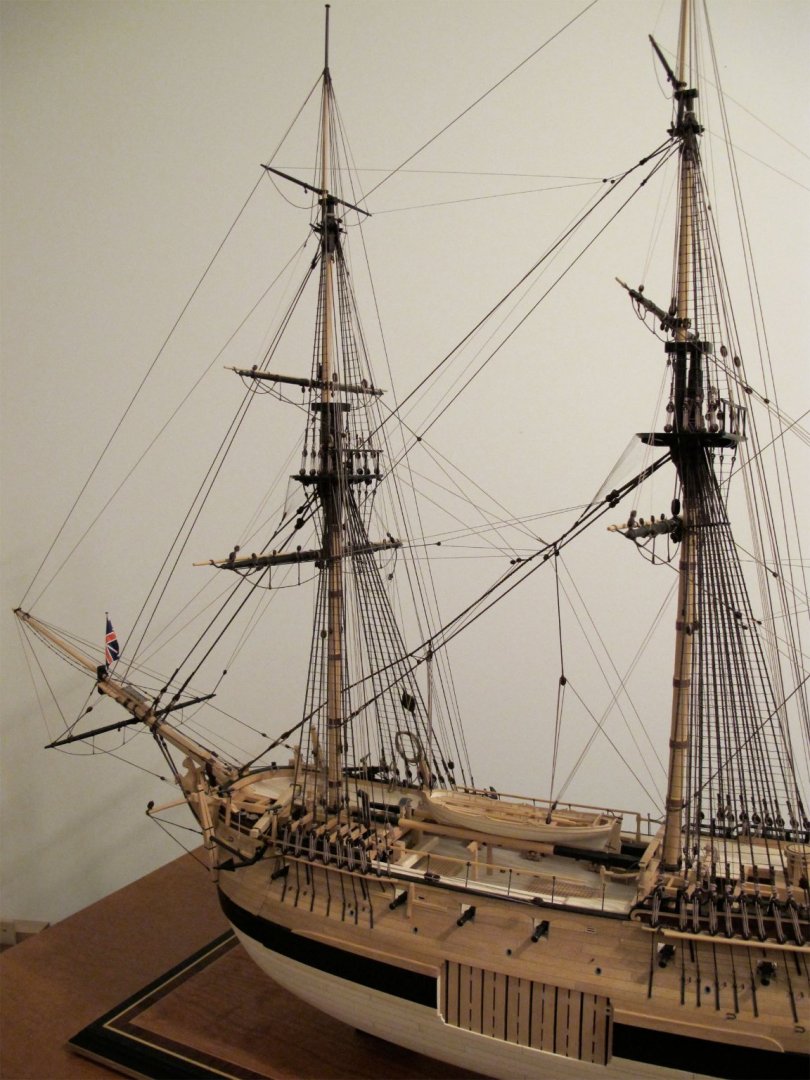-
Posts
13,369 -
Joined
-
Last visited
Content Type
Profiles
Forums
Gallery
Events
Everything posted by druxey
-
Ron: Guilty as charged, m'lud. And yes , they had to fish out the anchor by the shank once it was above water.
- 542 replies
-
- Sphinx
- Vanguard Models
-
(and 3 more)
Tagged with:
-
A fish davit was, as the name implies, used specifically for anchor operations. It was replaced by a short davit in around 1800. For raising ships' boats or other heavier items, tackles on the mainstay and yardarms was used. You could not swing items inboard simply using a fish davit. A fish davit is rigged in the accompanying photo as are tackle from the mainstay and yardarms to the boat in the waist. .
- 542 replies
-
- Sphinx
- Vanguard Models
-
(and 3 more)
Tagged with:
-
Interesting photo of Lowestoft. However, think of the weight of that spar, then having to heave it outboard even more before you can slip the end back through the spanshackle. It would probably tip overboard, the laws of physics being what they are. An illustration in Falconer shows a little less than half the length of the davit outboard, The model photo may be suspect, as so many models were re-rigged or 'restored' over the years. I'm having particular difficulty with a research project, where very old repairs are almost impossible to distinguish from original work.
- 542 replies
-
- Sphinx
- Vanguard Models
-
(and 3 more)
Tagged with:
-
I believe that the spanshackle on the opposite side of the forecastle was used to secure the inboard end of the fish davit. As you haae it, the leverage would place severe strain on the spanshackle bolt, even though it extends down through two beams below.
- 542 replies
-
- Sphinx
- Vanguard Models
-
(and 3 more)
Tagged with:
-
There are some very strange English terms, Siggi! You would probably laugh at my German language skills.
-
Almost right! It's called a 'shankpainter chain'. It is taken around the shank of the anchor when it is stowed.
-
If you have not yet read Kurt Van Dahm's article on shop safety in the current Nautical Research Journal (pp.375-381), please take the time to do so. It may save you a lot of grief.
-
Terrific work. I love the panelling detail inside the wheelhouse. How much will one be able to see once the model is complete?
-

Why masts are square at the top?
druxey replied to Tommy Vercetti's topic in Masting, rigging and sails
Wefalck: um, see response #2! -
There are several ways of making grommets. One way is cutting thin slices of brass tubing (heat-soften it first!) Place the ring on a hardened surface and flare one side using a center punch, if the ring is small enough. Push the ring through a hole in the sail and flare the other side to lock it in place.
-
In 18th century terms, a cringle is a rope loop at the corners of and along the edges of sails, either as part of the bolt rope or secured to it. Are you thinking, perhaps, of a grommet? That is a ring of metal fixed within the edge of a sail.
-

Swan-Class Sloop by Stuglo - FINISHED - 1:48
druxey replied to stuglo's topic in - Build logs for subjects built 1751 - 1800
Making paper or thin card patterns for any complex piece saves a lot of wood (and bad language!). Your counter planking looks good.- 475 replies
-
Good progress, but had you considered using SilkSpan instead of woven material, however fine? It's much more amenable to furling.
About us
Modelshipworld - Advancing Ship Modeling through Research
SSL Secured
Your security is important for us so this Website is SSL-Secured
NRG Mailing Address
Nautical Research Guild
237 South Lincoln Street
Westmont IL, 60559-1917
Model Ship World ® and the MSW logo are Registered Trademarks, and belong to the Nautical Research Guild (United States Patent and Trademark Office: No. 6,929,264 & No. 6,929,274, registered Dec. 20, 2022)
Helpful Links
About the NRG
If you enjoy building ship models that are historically accurate as well as beautiful, then The Nautical Research Guild (NRG) is just right for you.
The Guild is a non-profit educational organization whose mission is to “Advance Ship Modeling Through Research”. We provide support to our members in their efforts to raise the quality of their model ships.
The Nautical Research Guild has published our world-renowned quarterly magazine, The Nautical Research Journal, since 1955. The pages of the Journal are full of articles by accomplished ship modelers who show you how they create those exquisite details on their models, and by maritime historians who show you the correct details to build. The Journal is available in both print and digital editions. Go to the NRG web site (www.thenrg.org) to download a complimentary digital copy of the Journal. The NRG also publishes plan sets, books and compilations of back issues of the Journal and the former Ships in Scale and Model Ship Builder magazines.




